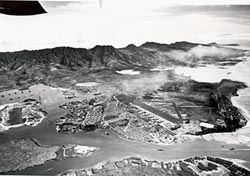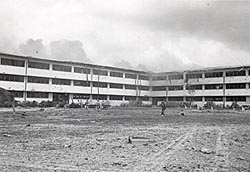
Hickam Field, adjacent to Pearl Harbor U.S. Naval Base, was established in 1935 as Hawaii's principal army airfield and bomber base. On December 7, 1941, 51 airplanes were on the ground at Hickam, the headquarters of the Hawaii Air Force, and a flight of 12 B-17s was expected to arrive that morning. The first wave of the Japanese attack on Pearl Harbor was primarily targeting battleships and carriers, but the airfields were also to be hit to prevent a counterattack against the Japanese bombers and torpedo planes.
At Hickam Field, Japanese Zero fighters and Val dive-bombers strafed and bombed the fight line and hangars, concentrating on the B-17 bombers. The 12 U.S. B-17s arrived unarmed and low on fuel during the attack. Most succeeded in landing at Hickam where they were attacked on the ground. The second wave of the Japanese attack struck Hickam at 8:40am and by 9:45 the attack was over. Nearly half of the airplanes at Hickam Field had been destroyed or severely damaged. The hangars, the Hawaiian Air Depot, several base facilities--the fire station, the chapel and the guardhouse--had been hit.

The big barracks had been repeatedly strafed and bombed and a portion of the building was on fire. Thirty-five men were killed when a bomb hit the mess hall during breakfast. Hickam's casualties totaled 121 men killed, 274 wounded and 37 missing. Despite the damage inflicted by the Japanese, they ignored the vital repair facilities and gasoline storage tanks at Hickam, Pearl Harbor and elsewhere on Oahu. Hickam Field emerged from the attack stronger than before and played an important role in World War II and since. Today, Hickam is the headquarters of the Pacific Air Force.
Visit the National Park Service Travel American Aviation to learn more about Aviation related Historic Sites.
Tags
- aviation history
- national register of historic places
- airplanes
- national landmarks
- heritage travel itineraries
- discover our shared heritage
- historic properties
- travel itineraries
- hawaii
- historic air fields
- naval aviation
- historic locations
- military aviation
- military
- aviation
- history
- oahu
- pearl harbor
Last updated: August 15, 2019
